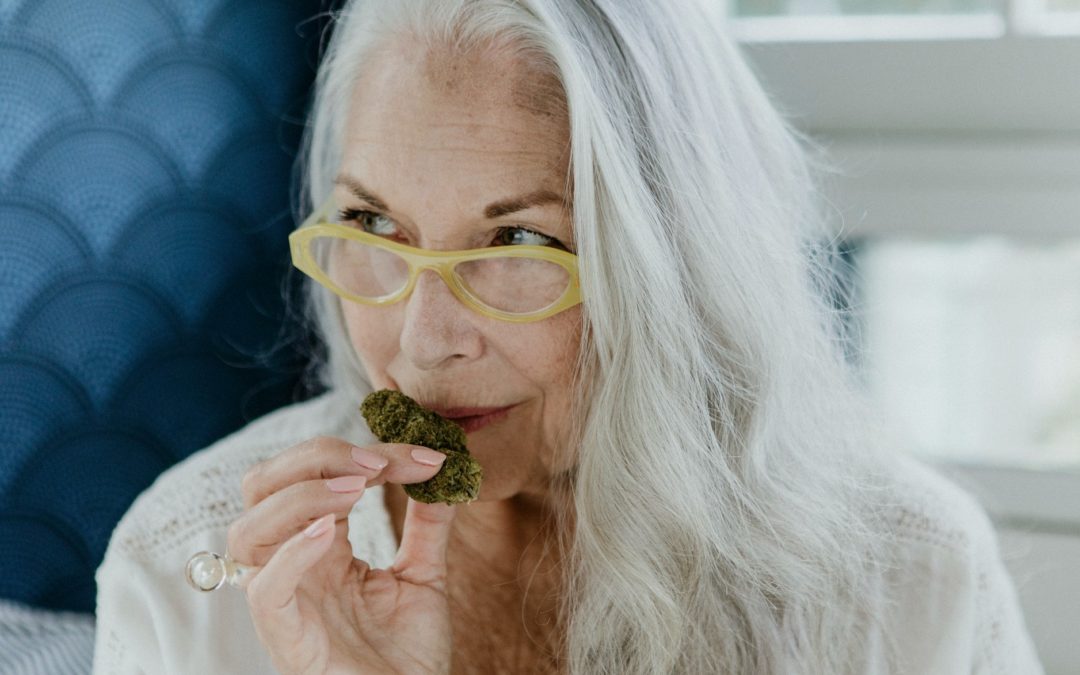
Older Adults and Cannabis
Cannabis products are seeing legalization all around the country and with the widespread popularity of these products, cannabis use is starting to cross generational lines. What does this mean for the industry, and for its newest customers?
Boomers and Cannabis
A recent study has shown that overall, marijuana and cannabis is on the rise with baby boomers in the United States. Men in particular are finding their way to it as a treatment for a number of different ailments [1]. Why is this so significant? Well, historically older adults have been against cannabis products, even those who a decade ago did not support cannabis legalization have since started to change their minds.
The findings of this study represent the changing attitudes of older Americans across the country when it comes to cannabis and marijuana use. Not only did use of cannabis increase in older adults in states where it has been legalized recreationally, but also in states where it has not. Researchers note that this phenomenon signifies a change in thinking across the entire country.
This particular study looked at three years of data, collected between 2016 and 2018 in adults aged 55 and up. The data comes from 19 states and two territories, and focuses on cannabis use in those participants.
Men between the ages of 60 to 64 were shown to have the highest rates of marijuana use, with the number of men using it jumping to 12.6% in 2018 compared to 8.9% in 2016. The study also showed that during the same time period cannabis use in men between the ages of 65 to 69 and 70 to 74 almost doubled. This is an impressive number in such a relatively short period of time. Research has shown, though, that the rates of cannabis use in women remained steady over the course of the study.
Scientists are still digging into what has caused such a shift recently, but the overall consensus is that more older adults are willing to use cannabis now because of the reduced stigma attached to it, increased availability of it, lowered inhibitions against cannabis, and the ever-growing list of medicinal benefits. Some of the most important of those benefits being help with chronic pain, anxiety, and sleep conditions [2]. As more older adults start to face these issues and also face the risk of certain prescription medications, they find themselves reaching for cannabis products.
Effects of Cannabis on Older Adults
Current research shows that cannabis has much the same effect on older adults as it does on younger. Afterall, it interacts with the body in the same way no matter the age of the user. Cannabis finds its way via the endocannabinoid system, or the ECS. This system controls homeostasis within the body. If the body senses any kind of disturbance happening internally, the ECS will kick into gear and point its resources to that disturbance, working to again bring stability to it. The ECS functions using three primary elements called endocannabinoids, receptors, and enzymes.
- The endocannabinoids are chemical compounds found within the human body. These compounds are very similar to the compounds found in cannabis, called cannabinoids. Since the two compounds are so molecularly similar, cannabinoids can easily attach themselves to endocannabinoid receptors.
- The receptors are found on the surface of cells throughout the body. When cannabinoids attach to the receptors, they are able to communicate with different systems, ultimately helping the ECS maintain homeostasis.
- Enzymes within the ECS are introduced after the receptor and cannabinoid compounds have worked together to achieve the desired level of stabilization in the desired system. Once homeostasis is achieved, the enzymes attach to the cannabinoids and break them down.
Risks
Some are concerned with the possibility of drug interactions when older adults start mixing their medication with cannabis products. A recent study indicated that there is potential for marijuana to interact with certain heart medications when they are combined, potentially putting those users in increased risk of cardiovascular issues. The study also noted increased risk of confusion, dizziness, falls, and other accidents [3]. Everyone adding any sort of cannabis product into their routine needs to speak with their doctor beforehand. It’s not worth the potential risk when it just takes a few moments to ask questions. Research is ongoing and new information is constantly being released, so keeping up-to-date on potential issues, as well as reporting any new side effects to a doctor, are essential right now as the industry grows and spreads to more and more demographics.
Uses
As mentioned earlier, some of the most common uses older adults have for cannabis include uses to help ease pain, anxiety, and sleep conditions. There are many other helpful uses for cannabis, including help with issues related to aging like inflammation, glaucoma, and Alzheimer’s, but we’ll discuss just the most common in this article.
Pain
Arthritis Pain
In the United States 23% of adults suffer from arthritis [4]. Arthritis can affect just one joint or several, and is most commonly seen in people over the age of 65 [5]. Researchers have been studying the benefits of cannabis on arthritis pain and the results are very positive. Their studies have indicated that CBD and other cannabis products may help reduce inflammatory pain by changing the way pain receptors react to stimuli [6]. It may also work to reduce joint inflammation and protect the nerves [7]. While there are other treatments for arthritis pain available, many of them have less than desirable side effects. Cannabis can offer a reliable option for pain management without the risk of dangerous side effects.
Back Pain
Lower back pain is the leading cause of disability around the world [8]. Some back pain can be resolved by rest alone, but many other types require treatment for recovery. Instead of taking prescription opioids for back pain, many are turning to cannabis. CBD, for instance, has no dangerous side effects, is not habit forming, and has been shown to be an helpful option for managing inflammatory back pain [9]. Using CBD along with stronger medications may be able to help a person reduce their need for more potent pills. That means combining CBD with stronger pain medication may help cut down on dependency and the harmful side effects that go along with it [10].
Neuropathic Pain
Chronic neuropathic pain comes from damaged nerves, which is different when compared to the tissue pain described above. Research has shown that cannabis may be a treatment option for both types of pain, with many people swearing by cannabis and CBD as a treatment for their neuropathic pain, including nerve trauma and widespread nerve damage [11]. Neuropathic pain is one of the most difficult to treat, yet current studies have revealed that cannabis can be beneficial to those patients who have not responded well to pharmaceutical treatments [12].
Anxiety & Stress
Studies have shown that cannabis interacts with two specific ECS receptors found in the central nervous system. Research is still ongoing, but these tests show that the cannabinoid CBD may alter serotonin signals, particularly the receptor that has the largest role in anxiety disorders [13].
As mentioned earlier, the endocannabinoid system and CBD work hand-in-hand and this is very much the case when it comes to treating anxiety disorders. The ECS is responsible for regulating stress and anxiety in the body, so when the system becomes overloaded, it is up to the ECS to make the necessary adjustments. Researchers believe that introducing cannabinoids to the ECS can have a positive overall effect on anxious behaviors [14].
CBD is also believed to assist in neural regeneration [15]. High levels of stress and anxiety for prolonged periods of time can cause damage to the neurons and the brain. In order to correct that damage, new neurons must be formed and new connections made. CBD helps boost this corrective process and stimulates growth of new neurons, resulting in reduced anxiety.
Sleep Conditions
There are several factors to consider when investigating cannabis for sleep. First, consumers should determine which cannabis product they would like to try for sleep. Marijuana has been used for centuries as a natural sleep aid [16], however because it does possess psychoactive effects many potential users avoid it. While it is a powerful sleep aid, it may not be for everyone. If consumers would rather avoid the intoxication of THC, they should still be aware that CBD contains a terpene called myrcene. This particular terpene is known to act as a sedative [17] and is a powerful addition to cannabidiol.
Another factor to consider is the type of CBD being used to assist in sleep. If a consumer decides to use a CBD isolate, they will be missing out on the added benefits that comes with using a more inclusive CBD product, like broad or full spectrum CBD oil. The products that are listed as CBD isolate will have all other cannabinoids and terpenes removed, leaving only pure CBD. While this might be an excellent product for many other uses, it may not be the best product for someone looking for relief from sleep conditions because then they are missing out on a very special process called The Entourage Effect, which only happens when all cannabinoids and terpenes are allowed to exist together and aid each other in their processes, bringing maximum relief to the user. If even one of those compounds is removed, the beneficial results will be lessened [18].
Risks
Some are concerned with the possibility of drug interactions when older adults start mixing their medication with cannabis products. A recent study indicated that there is potential for marijuana to interact with certain heart medications when they are combined, potentially putting those users in increased risk of cardiovascular issues. The study also noted increased risk of confusion, dizziness, falls, and other accidents [19]. Everyone adding any sort of cannabis product into their routine needs to speak with their doctor beforehand. It’s not worth the potential risk when it just takes a few moments to ask questions. Research is ongoing and new information is constantly being released, so keeping up-to-date on potential issues, as well as reporting any new side effects to a doctor, are essential right now as the industry grows and spreads to more and more demographics.

